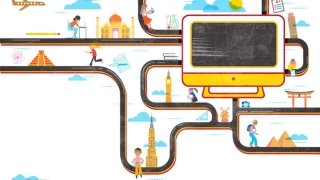A decade ago, the idea that online classrooms could rival the brick-and-mortar campus largely drew scoffs. USC Rossier Dean Karen Symms Gallagher included herself among the skeptics.
But a new education technology company changed her mind, and a unique partnership unfolded between USC’s then-90-year-old graduate school of education and the startup that became 2U. It resulted in USC Rossier’s online Master of Arts in Teaching program, launched in 2009.
Dubbed MAT@USC, the program was identical to USC Rossier’s campus-based MAT in admission standards, curriculum and tuition, but it blew up the traditional classroom, using 2U’s robust technology to connect faculty and students in far-flung locations in real time.
As the first major graduate school of education to prepare new K–12 teachers online, USC Rossier was “an island nation of innovation” in a tradition-bound world, The Atlantic wrote in 2011. By then, the magazine noted, the move to digital had brought USC Rossier more master’s students in education—1,500—than Harvard and Stanford combined. Its success would help transform the global conversation about the viability of online graduate education.
USC Rossier now has five master’s and two doctoral programs online, with 4,000 alumni. Ninety-four percent of graduates in 2017 were employed within a year of graduation, 85 percent of them in the education field, 2U figures show.
Although demand leveled off after 2012 due to school district layoffs and other residual effects of the 2008–09 recession, MAT@USC remains the largest online teacher prep program among top-ranked U.S. schools of education, according to 2U.
“People often ask me: ‘Why did they do it?’” 2U co-founder and CEO Christopher “Chip” Paucek says of the gamble undertaken by Dean Gallagher and the USC Rossier faculty. “We had absolutely no track record, but Karen believed we could pull it off. She had to take a huge risk, and she went for it.”
Gallagher had become dean in 2000 when the school was struggling. Within her first few years, she led major efforts to right its course, including stabilizing an up-and-down budget and overhauling the doctoral programs.
The school also revamped its mission to focus on improving urban education locally, nationally and globally, but it was constrained by a teacher preparation program that could serve only 50 to 75 students a year.
“Our program was so small,” Gallagher says, “it was hardly meeting those needs.”

“We have a guiding principle at 2U: Don’t let the skeptics win,” says CEO Chip Paucek. “Everything about this seemed absurd to most people, but not to Dean Karen Gallagher. Every step required someone at USC to push it forward.”
She had initiated conversations with faculty about an online venture, but they didn’t turn serious until spring 2008, when future USC Rossier faculty member Alan Arkatov introduced her to Princeton Review founder John Katzman, who was starting an ed tech company.
Katzman “had a two-part idea,” Gallagher recounts. “One was that highly selective universities at the master’s level ought to look at scaling up and have a bigger reach. The second was that you could prepare people new to the profession of teaching with an online program. That was novel.”
The company, which was later rechristened 2U, offered capital and technical know-how to expand USC Rossier’s capacity without the school having to worry about classroom space.
“We didn’t have the technology skills. That scared the faculty most,” Professor of Clinical Education Margo Pensavalle recalls. “But Karen said, ‘You have the opportunity to develop the best program you can.’ With that, all the doors opened.”
Pensavalle volunteered for the design team led by Professor Etta Hollins, who was Rossier’s chair of teacher education, and then-Associate Dean Melora Sundt. The team started in April; by August they had pulled in all the other faculty.
With this input, 2U set about building a platform that could deliver live classes and content with 24/7 access around the world. The company would also provide technical support and training, placement services for student teachers, and marketing.
The faculty would make all decisions about curriculum, including what parts of courses would be delivered live and how those sessions would be scheduled. Faculty also wanted online office hours, electronic bulletin boards and chat rooms for students that allowed faculty participation.
While plotting the online experience, the faculty was also redesigning the MAT curriculum. They built in a “constructivist” perspective that guided candidates to develop instructional practices based on what they could learn about their pupils’ cultural backgrounds and community expectations. The faculty also revamped the field experience to provide training to supervising teachers and help them improve their own practice.
“We didn’t just take the program we had and put it online,” says Hollins, an authority on urban education who is now retired. “Every single course and experience was redesigned.”
The revamped curriculum was rolled out on campus at the same time that the online program went live, in June 2009.
The first-year enrollment of 142 students was about double the size of the on-campus program. With five rolling starts a year, it mushroomed rapidly, surging past 1,000 students in 2010. To keep up with demand, the school hired a dozen new full-time faculty members.
With an enticing interface that featured interactive chat boxes, Facebook-like profiles and a lively grid of video feeds, MAT@USC defied negative stereotypes of online learning.
“We had a few students in the face-to-face program who chose to switch to online,” Hollins recalls. “They thought they had more access online to professors and peers, but it was essentially all the same.”
The first year was grueling.
“We needed to learn all the technology tools and were dealing with brand-new syllabi and curricula—everything had been innovated,” Pensavalle says. “We were 2U’s very first school, so we were walking carefully.”
The learning curve was steep for 2U’s team, too. They had to figure out how to streamline textbook ordering and how to store grades and student work online. They were continually rebuilding classes to address technological glitches or improve users’ access to stored content, such as readings and videos, during live sessions.
The program’s requirement for video assessment of MAT candidates during student teaching also brought challenges. In traditional programs, supervising teachers observe during classroom visits, but if the student is in Atlanta, for example, and the guiding teacher is in Los Angeles, video recording provided the best solution.
“We ran into problems with the quality of the lesson videos they collected, with the 2U platform accepting the videos and with districts being uncomfortable with candidates recording in classrooms,” says MAT chair John Pascarella, who was USC Rossier’s faculty director of fieldwork for four years. “We had to help districts understand the value and purpose of the recordings for initial teacher preparation.”

“USC Rossier faculty had to decide what online would mean and look like,” says Etta Hollins, then the school’s chair of teacher education. “2U entered with a platform that would support whatever program we designed.”
USC Rossier now has partnerships with more than 6,000 schools across the country, according to Carolyn Kim, who manages teacher placements for 2U. A longitudinal study by WestEd, a San Francisco-based research firm, provided a largely positive view of online students’ experiences.
“The on-ground students did not have a qualitatively better experience than the online students. And the online students felt as powerfully connected to us as the on-ground students did,” Gallagher says of the findings from the five-year study concluded in 2016.
The first graduation ceremony, in 2010, brought proof of that connectedness.
“An equal percentage of online and on-ground students attended,” Paucek recalls. “That’s when we knew we were on to something.”
Yvonne Thevenot MAT ’14 can attest to the online program’s ability to foster relationships. She had been working in IT and finance for a Fortune 500 company in New York when she decided to seek a more fulfilling career. She knew that she thrived on interacting with people and didn’t want to learn by “just watching videos” on her computer.
“That narrowed it down to USC,” she says. After starting the program in 2013, she found that although her classmates were scattered around the country and globe—including Britain, Turkey and several Asian countries—the 2U platform made it easy to engage with them in chats and group projects.
“Everything was the same as if I was on campus. That was just super appealing to me,” says Thevenot, who later started STEM Kids NYC to teach disadvantaged students computer science and engineering skills. “I’m the fruit of the labor that started at USC Rossier. It allowed me to get into the world of education justice.”
Now in its 10th year, the online MAT program draws students from all 50 states and the District of Columbia, as well as from four U.S. territories and 33 countries, particularly South Korea, China and Japan.
The program’s success encouraged five other USC schools to work with 2U on their own online ventures, the most recent being the USC Price School of Public Policy; 2U now has 35 university partners and supports 68 online degree programs at institutions across the country.
“The partnership with USC Rossier built the entire company,” Paucek says. “We’re here to support a great university and support what it does extremely well. A school like USC is a pretty magical place. You just need to figure out how to bring that to the online environment.”
For USC Rossier, working with 2U has paid huge dividends, some of which were unimaginable in 2008. In recent years, a USC Rossier team built the platforms for two master’s programs—Learning Design and Technology, and Enrollment Management and Policy—and the EdD in Educational Leadership for professionals working in K–12 settings.
“We could not have gone online without 2U, but this experience really changed us—we came away from it saying, ‘Well, we can do some of these things ourselves,’” says Gallagher. “The online master’s is an idea that is here to stay. We just have to keep improving the quality of the experience.”




